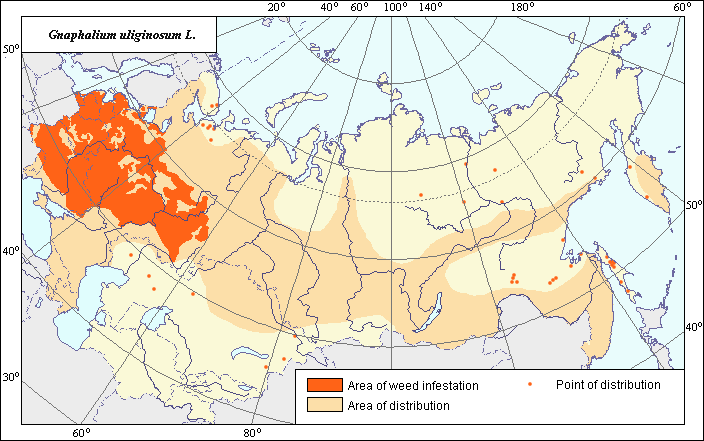Weeds
Area of distribution and weediness of Gnaphalium uliginosum L.
 Object description Download GIS-layers
Object description Download GIS-layers
Authors:
Object specialist I.N. Nadtochii, GIS-specialist I.A. Budrevskaya.Date of creation:
20.08.2004.Scale:
1:20 000 000.Accuracy of map:
Map was created based on information taken from open-published literature and on maps of natural scale 1: 17 000 000 and larger.Projection:
"Alber's Equal Area Conic for the USSR", 9, 1001, 7, 100, 0, 44, 68, 0, 0.Basic contents:
Vector map. Area of species distribution is shown by polygons, and sporadic distribution by points. Zones of weediness are shown by polygons.Accuracy of classifier:
The weed area is subdivided into two zones, one representing species distribution, and the second where weed is considered a serious pest. Points represent locations where sporadic occurrence has been reported. The zone of weediness was established according to criteria of occurence of this species and abundance (Tanskii et al., 1998). Within the limits of this zone G. uliginosum was characterized by having a 10-20% frequency of occurrence and 2-3 points of abundance.Method of map production:
Published literature was reviewed, including Atlases, monographs and papers. Occurrence data were obtained from herbarium specimens, floras, monographs and papers. The following sources were used to determine the areas of G. uliginosum: Hulten & Fries (1986), Chikov (1983), Tolmachev (1976), Kharkevich (1992), Gorodkov (1966). A map by Chikov (1983) was used as base map, corresponding completely with the area of main distribution of the weed. Places of sporadic distribution were determined according to the following sources: Hulten & Fries (1986), Chikov (1983), Kharkevich (1992), Tolmachev (1976), Gorodkov (1966). The zone of weediness was determined based on literature data. Criterion of its allocation is the indication of the weed as frequently being found in fields of the Central part of the Non-Chernozem and Chernozem zones (Zakharenko & Zakharenko, 2004), as a background species in fields of the Non-Chernozem zone (Spiridonov, 2004), as a main species in Nizhnii Novgorod Region (Tikhornova, 1937), as a main weed of grain crops, winter rye, and potato in Byelorussia (based on the work of Kozlovskaya & Simonovich (1966), Padenov & Samersov (1997) and Samersov et al. (2000)), as the most widespread weed in Lithuania (Monskvilaite & Shalna, 1972), as a pernicious weed of winter rye and most widespread weed of winter wheat in Moscow Region (based on the work of Blagoveshchenskii (1966) and Populovskaya (1936)). Data were then compiled through scanning and geo-referencing to develop a composite vector map. The biologist, together with the GIS specialist, drew a composite weed distribution area based on compiled data.Reference citations:
Blagoveshchenskii A.V., ed. 1966. Keys to plants of Moscow Region. Moscow: Nauka. 368 p. (In Russian)Chikov P.S., ed. 1983. Atlas of areas and resources of herbs of the USSR. Moscow: VNIILR, BIN, LGU, TGU. 340 p. (In Russian)
Gorodkov, B.N., ed. 1966. Flora of Murmansk Region. V. 5. Moscow-Leningrad: AN SSSR. 551 p. (In Russian)
Hulten E., Fries M. 1986. Atlas of North European Vascular Plants, North of the Tropic of Cancer. Konigstein. V. 1-3: 1172.
Kharkhevich S.S., ed. 1992. Vascular plants of the Soviet Far East. V. 6. Saint Petersburg: Nauka. 428 p. (In Russian)
Kozlovskaya N.V., Simonovich L.G. 1966. Features of weed distribution on turfy-podzol soils of Polesye region. In: Yurkevich I.D., ed. Geobotanical research. Minsk: Nauka i tekhnika. 56-64 p. (In Russian)
Monskvilaite YA., Shalna A. 1972. Change of botanical structure of weed plants under the influence of amine salt 2.4-D. In: Piletskis S. Brief reports on questions of plant protection. Kaunas: Ministry Agr. Lithuanian SSR, Republican station of plant protection, Lithuanian agricultural academy, Lithuanian research institute of agriculture. Part 3: 13-17. (In Russian)
Padenov K.P., Sammersov V.F. 1997. Weed plants in Byelorussia. Zashchita i karantin rastenii, 1: 18-19. (In Russian)
Populovskaya N.M. 1936. Weediness of crops of collective farms Mytishchino district of the Moscow Region. In: Bogoslovskii A.S., Kulaev S.I., eds. Proceedings of Bolshevskaya biological station. Bolshevo: Bolshevskaya biological station. 109-115 p. (In Russian)
Samersov V.F., Padenov K.P., Soroka S.V. 2000. Weediness of crops in Byelorussia and methods of its reduction. Zashchita i karantin rastenii, 3: 20-22. (In Russian)
Spiridonov Yu.Ya. 2004. Features of species structure of weed vegetation in modern agrocoenoses of the Russian Non-Black Earth Region. Plant Protection News (VIZR), 2: 15-24. (In Russian)
Tanskii V.I., Levitin M.M., Ishkova T.I., Kondratenko V.I. 1998. Phytosanitary diagnostics in integrated managemant of cereals. In: Novozhilov K.V., ed. Compendium of methodical recommendations in plant protection. Saint Petersburg: VIZR. 5-55 p. (In Russian)
Tikhonova Z.E. 1937. Weeds and their control. Gor`kii: Gor`kii Regional Publishing House. 90 p. (In Russian)
Tolmachev, A.I., ed. 1977. Flora of North-East of the European part of the USSR. V. 4. Leningrad: Nauka. 312 pp. (In Russian)
Zakharenko V.A., Zakharenko A.V. 2004. Weed control. Zashchita i karantin rastenii, 4: 62-142. (In Russian)
Right and copyright:
All rights reserved.Copyright 2004© I.N. Nadtochii & I.A. Budrevskaya.
N.N. Luneva is the author of image (VIZR).

